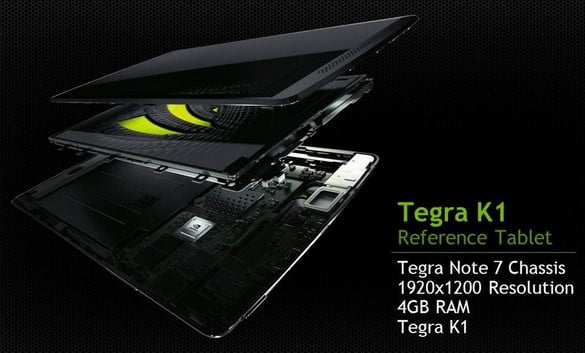NVIDIA CES 2014: Denver Debuts, Tegra K1 192 Cores
NVIDIA CES 2014: Denver Debuts, Tegra K1 Breaks Cover
NVIDIA's Jen-Hsun Huang took the stage at CES 2014 to discuss NVIDIA's overarching gaming technology efforts, starting with a discussion of PC gaming streaming courtesy of NVIDIA's Shield. We've discussed Shield's game streaming capability before -- it's easily one of the stronger selling points for the product. According to the NVIDIA CEO, the game streaming that the company showed at CES was actually being rendered from an NVIDIA GRID server that was currently located in France. The idea here? NVIDIA can render from thousands of miles away, push those frames to your PC or mobile device, and do it in a manner that feels like a local solution.
After covering a number of other NVIDIA innovations over the past year, NVIDIA unveiled its latest mobile chip. Not Tegra 5 -- NVIDIA appears to be dropping the five altogether -- but Tegra K1 (codenamed Logan).
NVIDIA ran through a number of mobile demos highlighting just how powerful the new core is, with the usual demonstration of impressive capabilities and lighting environments. Not that we're downplaying the performance or visual fidelity of Tegra K1 -- the new chip looks incredible -- but we've seen some of these demos from NVIDIA already, when it debuted Logan earlier this year.

Denver Debuts
The big news of the evening from NVIDIA was that we'd soon see two SKUs for Tegra K1 -- a quad-core Cortex-A15 32-bit chip at 2.3GHz, or a dual-core Denver at up to 2.5GHz and a whopping seven-way superscalar architecture. That's frankly enormous -- it means that Denver can execute up to seven instructions simultaneously. The "up to," however, is extremely important -- we don't know what kind of decode resources the Denver CPU has, which means we don't know how easily it can hit that execution capability.
Still, the phrase "go big or go home," seems to be appropriate here. And given how little software actually uses quad-cores outside of benchmarks, two massive dual cores with excellent performance characteristics may have been the way to go.
NV was mum on a ship date for either architecture but indicated that the Denver-based chip had only just gotten back from the foundry in a useable form. So it's safe to say we won't see Denver shipping in products until the back half of the year, given the typical ramp time. The 192-core Kepler-based Tegra K1 with standard Cortex-A15 cores should be ready to ramp well before that.
What NVIDIA has done here is bring Denver to market earlier than anticipated, while simultaneously avoiding betting solely on the new CPU uarch. With a 32-bit Cortex-A15 flavor and a dual-core coming later, the company should be able to target a wider range of markets. If something does go wrong with Denver yields, NVIDIA won't be stuck without a product to sell in this space.
It'll be exciting to see just how much performance NVIDIA can squeeze out of its new architectures -- this could be the GPU that reignites that company's flagging mobile business and brings PC-level gaming to mobile architectures at the same time.
After covering a number of other NVIDIA innovations over the past year, NVIDIA unveiled its latest mobile chip. Not Tegra 5 -- NVIDIA appears to be dropping the five altogether -- but Tegra K1 (codenamed Logan).
NVIDIA Tegra K1 Development Platform
NVIDIA ran through a number of mobile demos highlighting just how powerful the new core is, with the usual demonstration of impressive capabilities and lighting environments. Not that we're downplaying the performance or visual fidelity of Tegra K1 -- the new chip looks incredible -- but we've seen some of these demos from NVIDIA already, when it debuted Logan earlier this year.

Denver Debuts
The big news of the evening from NVIDIA was that we'd soon see two SKUs for Tegra K1 -- a quad-core Cortex-A15 32-bit chip at 2.3GHz, or a dual-core Denver at up to 2.5GHz and a whopping seven-way superscalar architecture. That's frankly enormous -- it means that Denver can execute up to seven instructions simultaneously. The "up to," however, is extremely important -- we don't know what kind of decode resources the Denver CPU has, which means we don't know how easily it can hit that execution capability.
Still, the phrase "go big or go home," seems to be appropriate here. And given how little software actually uses quad-cores outside of benchmarks, two massive dual cores with excellent performance characteristics may have been the way to go.
NV was mum on a ship date for either architecture but indicated that the Denver-based chip had only just gotten back from the foundry in a useable form. So it's safe to say we won't see Denver shipping in products until the back half of the year, given the typical ramp time. The 192-core Kepler-based Tegra K1 with standard Cortex-A15 cores should be ready to ramp well before that.
What NVIDIA has done here is bring Denver to market earlier than anticipated, while simultaneously avoiding betting solely on the new CPU uarch. With a 32-bit Cortex-A15 flavor and a dual-core coming later, the company should be able to target a wider range of markets. If something does go wrong with Denver yields, NVIDIA won't be stuck without a product to sell in this space.
It'll be exciting to see just how much performance NVIDIA can squeeze out of its new architectures -- this could be the GPU that reignites that company's flagging mobile business and brings PC-level gaming to mobile architectures at the same time.










